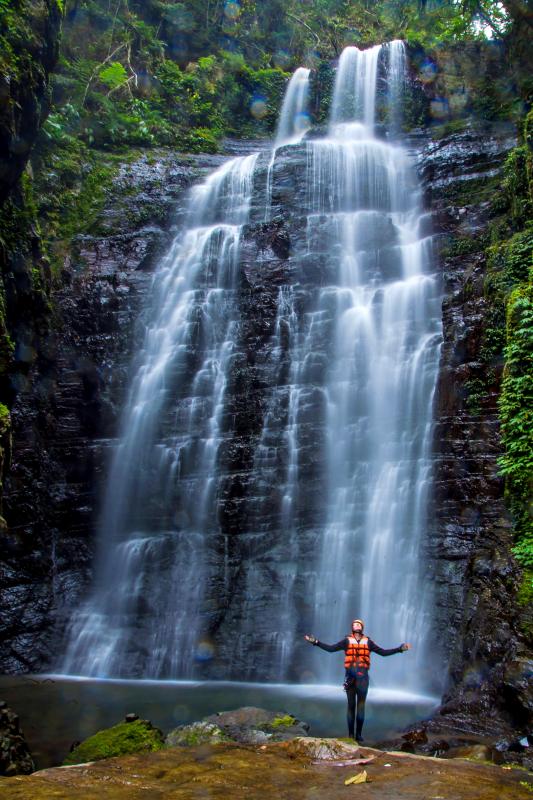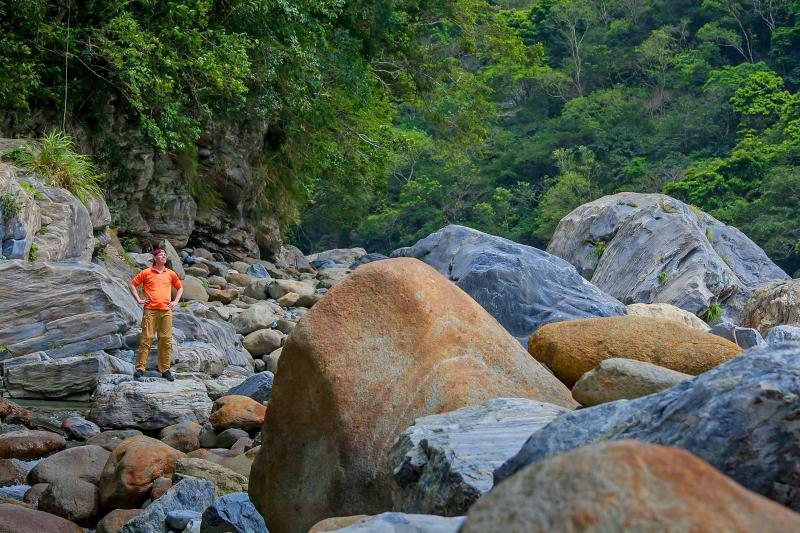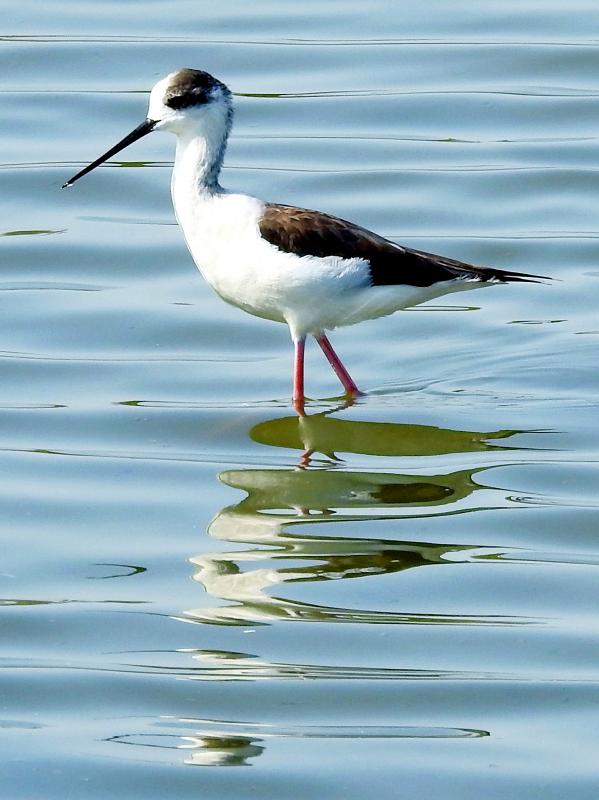It’s been a frustrating year for anyone who loves to travel. Throughout 2021, the risk of catching COVID-19 in another country, combined with strict quarantine requirements for those returning to Taiwan, deterred all but a few people from traveling overseas for fun. And just as Taiwanese were beginning to make plans for the summer, a domestic outbreak forced the government to raise the epidemic alert to level 3.
The situation is now much better. Taiwanese are once again able to enjoy all sorts of leisure activities. Night markets are crowded and tour groups have been making good use of the cooler months.
To find out where some of Taiwan’s most eager travelers aim to go next year — their New Year’s sightseeing resolutions, as it were — I spoke with three people who have strong personal and professional interests in tourism.

Photo: Steven Crook
REGENERATIVE EXPERIENCES
Stressing the health benefits of spending unhurried time outdoors, Michael McCreesh, who teaches tourism part-time at Ming Chuan University, says that he’s going to prioritize high-quality regenerative experiences next year.
“I love the vibe in big cities, but I need to recharge, and I can do that best in nature, with family or friends. Scientists have found that the neurological benefits include improved cognitive thinking and greater creativity. It lowers your blood pressure, too,” says the Canadian, who’s also studying for a PhD in recreational ecology at National Taiwan University.

Photo: Steven Crook
Fushan Botanical Garden (福山植物園) tops McCreesh’s list of places he hopes to visit next year. Located in New Taipei City’s Wulai District (烏來), but only accessible via Yilan County’s Yuanshan Township (員山), the botanical garden hosts an exceptional variety of animals, insects, plants and trees.
McCreesh says that he hasn’t yet been to Fushan Botanical Garden — which is managed by the Taiwan Forestry Research Institute — because visits must be arranged at least 35 days in advance, and no public transportation goes near the garden. Admission is free, but there’s a strict limit on visitor numbers.
He also wants to spend some time at Tataka (塔塔加), an ecologically rich part of Yushan National Park that can be accessed by Provincial Highway 18 or Provincial Highway 21. Given his children’s ages (seven and five), trips deeper into the mountains aren’t currently a realistic option, he says.

Photo courtesy of Johannes Twellman
McCreesh says that in the aftermath of the pandemic, there may be a shift in the style of tourism. International travel is likely to be more expensive, he says. People may end up taking fewer but longer trips, which at least would reduce the carbon emissions associated with air travel and long road trips.
“If people can take the time to get to know a place, and experience it at a human level, perhaps by meeting and learning from local artisans, tourism is less likely to be destructive, and can actually enhance the health of that destination,” McCreesh says. Two ventures he’s involved in, ParkBus and Origin Wild, reflect this ethos.
WILDLIFE WATCHING

Photo courtesy of Johannes Twellman
Victor Yu (余維道), president of Ecotourism Taiwan (台灣生態旅行促進會) and a member of the World Birdfairs Council, describes his goals for next year as “not too ambitious.”
He’d planned to go birding in Bhutan in March, but it’s looking less likely that he can go. For June, he has a trip to Ecuador and the Galapagos Island penciled in.
“Fingers crossed for that,” he says.

Photo: Steven Crook
In January, Yu is set to go birdwatching in Kinmen. After that, he’ll spend some time in Sun Link Sea Forest Recreation Area (杉林溪森林生態渡假園區) enjoying the sight of mountain-dwelling birds moving among cherry blossom.
But Yu’s top domestic objective for the coming year is the southwestern coast in the middle of August, especially Wangliao (網寮) in Chiayi County’s Dongshih Township (東石鄉) and Sidiliao (溪底寮) in Tainan’s Beimen District (北門).
“I want to see wading birds like the curlew sandpiper, dunlin, red-necked stint, red knot and black-tailed godwit — and, if I am lucky enough, the ruff — and get some good photos of them. I’ll be very happy if I can see some of those waders when they’re in their stunning breeding plumage.”
TAKING IT SLOW
Johannes Twellmann, a German who’s lived in New Taipei City for the past 20-odd years, is editor-in-chief of Travel in Taiwan, the official English-language magazine of the Taiwan Tourism Bureau.
The job entails frequent trips to different parts of Taiwan. During those excursions, Twellmann — who’s long been interested in photography — also shoots videos which he uploads to both YouTube and taiwaneverything.cc, a Web site owned by the company that publishes Travel in Taiwan.
“Because of my work, revisiting the same places is unavoidable, but surprisingly traveling in Taiwan never gets old for me,” he says.
Twellmann says that he’s always been keen to avoid places where tour buses are parked outside, or where he has to wait in line. He’d much rather spend his free time in a forest, or doing hikes “that are less about conquering peaks and more about exploring what’s beside the trails,” he says.
“I’d love to do more slow walks, taking in nature without hurrying, sitting down and composing photographs or videos, waiting for wildlife — that kind of thing strongly appeals to me,” Twellmann says.
Walking isn’t the only mode of transportation that appeals to Twellmann. He does a lot of YouBiking, and he confesses to an interest in flying: “Ultralight planes, hot-air balloons, paragliding: I’d like to try all of those.”
Despite having seen more of the country than many people who were born and raised in Taiwan, there are several places Twellmann still hasn’t yet been to, but would like to visit. Among them are Keelung Islet (基隆嶼), Turtle Island (龜山島), and some of the smaller islands in Penghu County.
“I love sparsely populated places that aren’t of interest to regular tourists,” he says. “I’d love to do more camping in natural surroundings, and search for treasure on secluded beaches. That’d be perfect!”
Steven Crook has been writing about travel, culture and business in Taiwan since 1996. He is the author of Taiwan: The Bradt Travel Guide and co-author of A Culinary History of Taipei: Beyond Pork and Ponlai.

April 14 to April 20 In March 1947, Sising Katadrepan urged the government to drop the “high mountain people” (高山族) designation for Indigenous Taiwanese and refer to them as “Taiwan people” (台灣族). He considered the term derogatory, arguing that it made them sound like animals. The Taiwan Provincial Government agreed to stop using the term, stating that Indigenous Taiwanese suffered all sorts of discrimination and oppression under the Japanese and were forced to live in the mountains as outsiders to society. Now, under the new regime, they would be seen as equals, thus they should be henceforth

Last week, the the National Immigration Agency (NIA) told the legislature that more than 10,000 naturalized Taiwanese citizens from the People’s Republic of China (PRC) risked having their citizenship revoked if they failed to provide proof that they had renounced their Chinese household registration within the next three months. Renunciation is required under the Act Governing Relations Between the People of the Taiwan Area and the Mainland Area (臺灣地區與大陸地區人民關係條例), as amended in 2004, though it was only a legal requirement after 2000. Prior to that, it had been only an administrative requirement since the Nationality Act (國籍法) was established in

Three big changes have transformed the landscape of Taiwan’s local patronage factions: Increasing Democratic Progressive Party (DPP) involvement, rising new factions and the Chinese Nationalist Party’s (KMT) significantly weakened control. GREEN FACTIONS It is said that “south of the Zhuoshui River (濁水溪), there is no blue-green divide,” meaning that from Yunlin County south there is no difference between KMT and DPP politicians. This is not always true, but there is more than a grain of truth to it. Traditionally, DPP factions are viewed as national entities, with their primary function to secure plum positions in the party and government. This is not unusual

US President Donald Trump’s bid to take back control of the Panama Canal has put his counterpart Jose Raul Mulino in a difficult position and revived fears in the Central American country that US military bases will return. After Trump vowed to reclaim the interoceanic waterway from Chinese influence, US Defense Secretary Pete Hegseth signed an agreement with the Mulino administration last week for the US to deploy troops in areas adjacent to the canal. For more than two decades, after handing over control of the strategically vital waterway to Panama in 1999 and dismantling the bases that protected it, Washington has